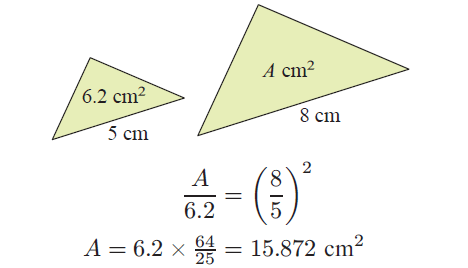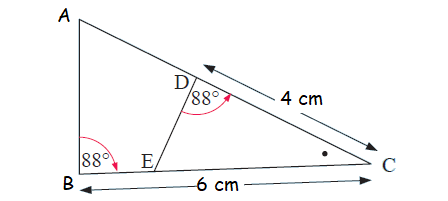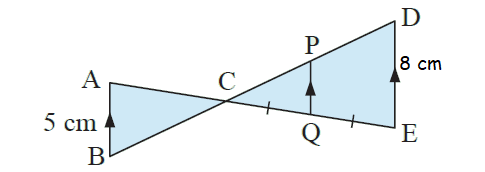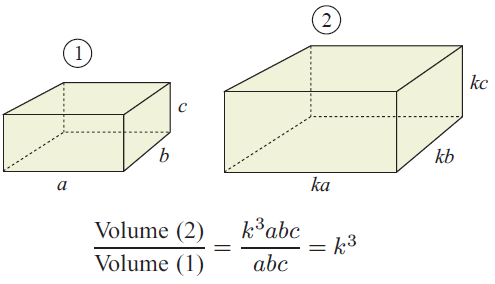AREA AND VOLUME OF SIMILAR FIGURES EXAMPLE PROBLEMS
If the corresponding sides of similar figures are in the ratio k, then :
Area of image = k2 x area of object.
For example, for the similar triangles alongside:

Example 1 :
Triangle DEC has area 4.2 cm2.
a) Find the area of triangle ABC.
b) Find the area of quadrilateral ABED.

Solution :
In the triangle given above, ΔABC and ΔDEC.
<BCA = <ECD (A)
ABC = <EDC (A)
ΔABC and ΔDEC are similar. Bases of triangle ABC and EDC are BC and DC respectively.
(i) Area of Δ ABC/Area of Δ DEC = (BC/DC)2
Area of Δ ABC/4.2 = (6/4)2
Area of Δ ABC = (36/16) x 4.2
= 9.45 cm2
(ii) Area of quadrilateral AEBD = Area of triangle ABC - Area of triangle DEC
= 9.45-4.2
= 5.25 cm2
So, area of quadrilateral is AEBD is 5.25 cm2.
Example 2 :
If triangle ABC has area 15 cm2:
a) find the area of ΔCDE
b) find the area of PQED.

Solution :
(a) In triangles ABC and CDE
AB is parallel to DE
Area of ABC/Area of CDE = (AB/DE)2
15/Area of CDE = (5/8)2
15/Area of CDE = 25/64
Area of CDE = 15(64)/25
= 38.4 cm2
In triangles CPQ and CDE
PQ is parallel to DE
Area of ΔCPQ/area of ΔCDE = (CQ/CE)2
CQ = x and CE = 2x
Area of ΔCPQ/38.4 = (x/2x)2
Area of ΔCPQ = 38.4/4
Area of ΔCPQ = 9.6
(b) Area of quadrilateral DPQE
= Area of CDE - Area of CPQ
= 38.4-9.6
= 28.8 cm2
If the corresponding sides of similar solids are in the ratio k, then :
Volume of image = k3 x volume of object.

Example 3 :
What will happen to the volume of:
a) a sphere if the radius is doubled
b) a sphere if the radius is increased by 20%
Solution :
Volume of sphere = (4/3)πr3
(a) Radius of the sphere = r
Radius of new sphere = 2r
Volume of new sphere = (4/3)π(2r)3
= (4/3)π(8r3)
= 8 x (4/3)πr3
So, volume of the new sphere will be 8 times volume of old sphere.
(b) Radius of sphere is increased by 20%.
Radius of new sphere = 1.20r
Volume of new sphere = (4/3)π(1.20r)3
= (4/3)π(1.728r3)
= 1.728 x (4/3)πr3
So, volume of the new sphere will be 1.728 times volume of old sphere.
Example 4 :
Triangle A is similar to Triangle B. If the scale factor of ΔA to ΔB is 4 to 5, what is the ratio of the perimeters of ΔA to ΔB? ____________ What is the ratio of the areas of ΔA to ΔB? __________________
Solution :
Since the corresponding sides are in the ratio 4 : 5, its perimeter will also be in the same ratio,
Area of triangle A : Area of triangle B = (4 : 5)2
= 42 : 52
= 16 : 25
So, the ratio between the area of triangles A and B is 16 : 25
Example 5 :
Pyramid X is similar to Pyramid Y. If the scale factor of X:Y is 3:7, what is the ratio of the surface areas of X:Y? __________ What is the ratio of the volumes of X:Y? ____________
Solution :
Surface area of Pyramid X : Surface area of Pyramid Y
= (3 : 7)2
= 9 : 49
Volume of Pyramid X : Volume of Pyramid Y
= (3 : 7)3
= 27 : 343
Example 6 :
The ratio of the surface areas of two similar cones is 16:49. What is the scale factor between the similar cones? __________ What is the ratio of the volumes of the similar cones? __________
Solution :
Let a and b be sides corresponding sides are cones.
Ratio between surface area of similar cone
(a/b)2 = 16/49
a/b = √(16/49)
a/b = 4/7
a : b = 4 : 7
Ratio between volume of similar cone
(a/b)3 = (4/7)3
a/b = (43/73)
a/b = 64/343
Ratio between volume = 64 : 343.
Example 7 :
Two spheres have a scale factor of 1:3. The smaller sphere has a surface area of 16 ft2. Find the surface area of the larger sphere.
Solution :
Ratio between sides lengths of sphere = 1 : 3
Let a and be the corresponding sides of sphere
Surface area of small sphere : Surface area large sphere = 12 : 32
16/surface area of large sphere = 1/9
Surface area of large sphere = 9(16)
= 144
Example 8 :
Two rectangular prisms are similar and the ratio of their sides is 2:3. The surface area of the larger rectangular prism is 1944 cm2. What is the surface area of the smaller rectangular prism?
Solution :
Ratio between corresponding sides = 2 : 3
Surface area of small rectangular prism : Surface area of small rectangular prism =
22 : 32
Surface area of small sphere / 1944 = 4 : 9
Surface area of small sphere / 1944 = 4/9
Surface area of small sphere = (4/9) 1944
= 864 cm2
Example 9 :
The ratio of the sides of two similar cubes is 3:4. The smaller cube has a volume of 729 m3. What is the volume of the larger cube?
Solution :
Ratio between corresponding sides = 3 : 4
Volume of small cube : Volume of large cube = 33 : 43
729 / Volume of large cube = 27 / 64
Volume of large cube = (64/27) (729)
= 1728 m3
Example 10 :
Pyramid X is similar to pyramid Y. The Surface area of pyramid X is 135 cm2, and the surface area of pyramid Y is 240 cm2. If the volume of pyramid X is 189 cm3, then what is the volume of pyramid Y?
Solution :
Let a and be be the corresponding sides of Pyramid X and Pyramid Y respectively.
(a : b)2 = 135/240
a2 / b2 = 135 / 240
a/b = √135/√240
a/b = 11.61/15.49
a/b = 0.75
Volume of small cube : Volume of large cube = (a/b)3
189/Volume of large cube = (0.75)3
Volume of large cube = 189/(0.75)3
= 450
Kindly mail your feedback to v4formath@gmail.com
We always appreciate your feedback.
©All rights reserved. onlinemath4all.com
Recent Articles
-
Digital SAT Math Problems and Solutions (Part - 150)
Apr 25, 25 11:46 AM
Digital SAT Math Problems and Solutions (Part - 150) -
AP Calculus AB Problems with Solutions (Part - 19)
Apr 24, 25 11:10 PM
AP Calculus AB Problems with Solutions (Part - 19) -
AP Calculus AB Problems with Solutions (Part - 18)
Apr 24, 25 11:06 PM
AP Calculus AB Problems with Solutions (Part - 18)
